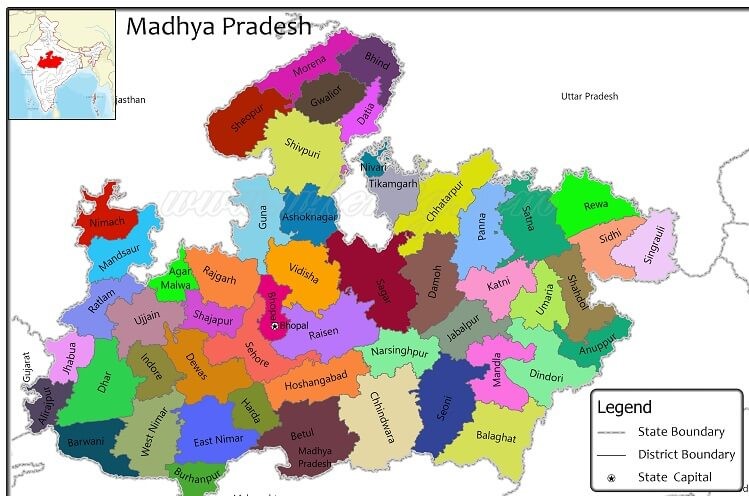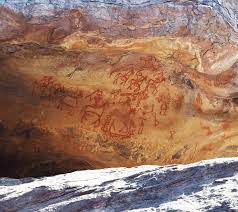- Home
- Tourism in India
- Madhya Pradesh
Madhya Pradesh
Madhya Pradesh
Country: India
State: Madhya Pradesh
Capital: Bhopal
Language: Hindi
Major Airports: Bhopal, Indore, Jabalpur, Gwalior, Ujjain, Khajuraho,
Best time to visit: October to March.
Total Area: 308,252 square kilometers
Major Tourism cities: Bhopal, Indore, Gwalior, Ujjain, Raipur, Maheshwar, Mandu, Omkareshwar, Orchha, Pachmarhi, Pench, Sanchi, Chitrakoot, Choral, Bhojpur, Bandhavgarh, Udayagiri, Amarkantak, Bhimbetka and many more
Major Tourist Attractions: National Parks, Forts, Museum, Tiger Reserves, Waterfalls, Lakes, Temples, Monuments many more
Update on coronavirus in India
Quick Links
Introduction:
Madhya Pradesh is a very important state located in the central part of India. The state is famous for its rich history and culture. As it can be said, “Madhya” central and Pradesh means region. It is home to many ancient temples, forts, and other historical sites. Madhya Pradesh is also known for its natural beauty, including dense forests, mountains, and lakes.
The state is also home to several national parks and wildlife sanctuaries, including the Kanha National Park, Bandhavgarh National Park, and Pench National Park. Narmada River, one of the most sacred rivers in India flows in the state. The state has diverse geographical features, including plateaus, hills, forests, and fertile plains. The Vindhya and Satpura mountain ranges run through the state, providing a varied landscape.
Bhopal is the capital of Madhya Pradesh, and the largest city is Indore. Madhya Pradesh is the second largest Indian state by area and the fifth largest state by population with over 72 million residents. It borders the states of Uttar Pradesh to the northeast, Chhattisgarh to the south- east, Maharashtra to the south-west, Gujarat to the west, and Rajasthan to the northwest.
The state is famous for five UNESCO Heritage Sites.
Bhimbiketa rock shelters. This site is home to over 750 rock shelters containing over 20,000 works of rock art, some of which are over 7,000 years old. The rock art depicts a variety of subjects, including human and animal figures, hunting scenes, and rituals.
Sanchi Stupas: This site is home to a group of Buddhist monuments, including stupas, temples, and pillars. The stupas are hemispherical structures that contain the relics of the Buddha. The Sanchi Stupas are some of the earliest and best-preserved examples of Buddhist architecture in India.
Khajuraho Temples: This site is home to a group of Hindu and Jain temples, famous for their intricate carvings and erotic sculptures. The Khajuraho Temples are a masterpiece of Indian architecture and one of the most popular tourist destinations in Madhya Pradesh. The two cities, Gwalior and Orchha, are UNESCO World Heritage Cities.
Climate and Geography of Madhya Pradesh
Climate and Geography
Madhya Pradesh, located in central India, boasts a diverse and varied geography, encompassing a wide range of landscapes and natural features.
The state is known for its extensive plateaus and highlands, which make up a significant portion of its land area. The two most prominent plateau regions are the Malwa Plateau in the west and the Baghelkhand Plateau in the east. The Malwa Plateau is relatively fertile and well-suited for agriculture. Northwest of the Vindhya range is the Malwa Plateau.
Rewa Plateau is towards the eastern region of the Vindya Range and the Baghelkhand Plateau is in the Northeast. Narmada River is one of the major rivers which runs between east and west in the Vindhya Ranges. Some of the other important rivers that flow in Madhya Pradesh include Mahanadi, Tapti and Wainganga River. The Dhupgarh Peak, near Pachmarhi in south-central Madhya Pradesh, is the state’s highest point.
Climate: The climate in Madhya Pradesh varies from tropical to subtropical. The summer months can be hot and dry, while the monsoon season brings heavy rainfall. The central and southern parts of the state experience more rainfall than the western and northern regions.
Summer Season: March to June is the summer month. The maximum temperature can hover around 45 degrees Celsius.
Monsoon season: July to September is the monsoon season. All the national parks would be closed during this season. The maximum temperature may hover around 35 degrees Celsius.
Winter season: November to February is the winter month. The minimum temperature may drop below 10 degrees in some places. It is considered as one of the best times to visit Madhya Pradesh.
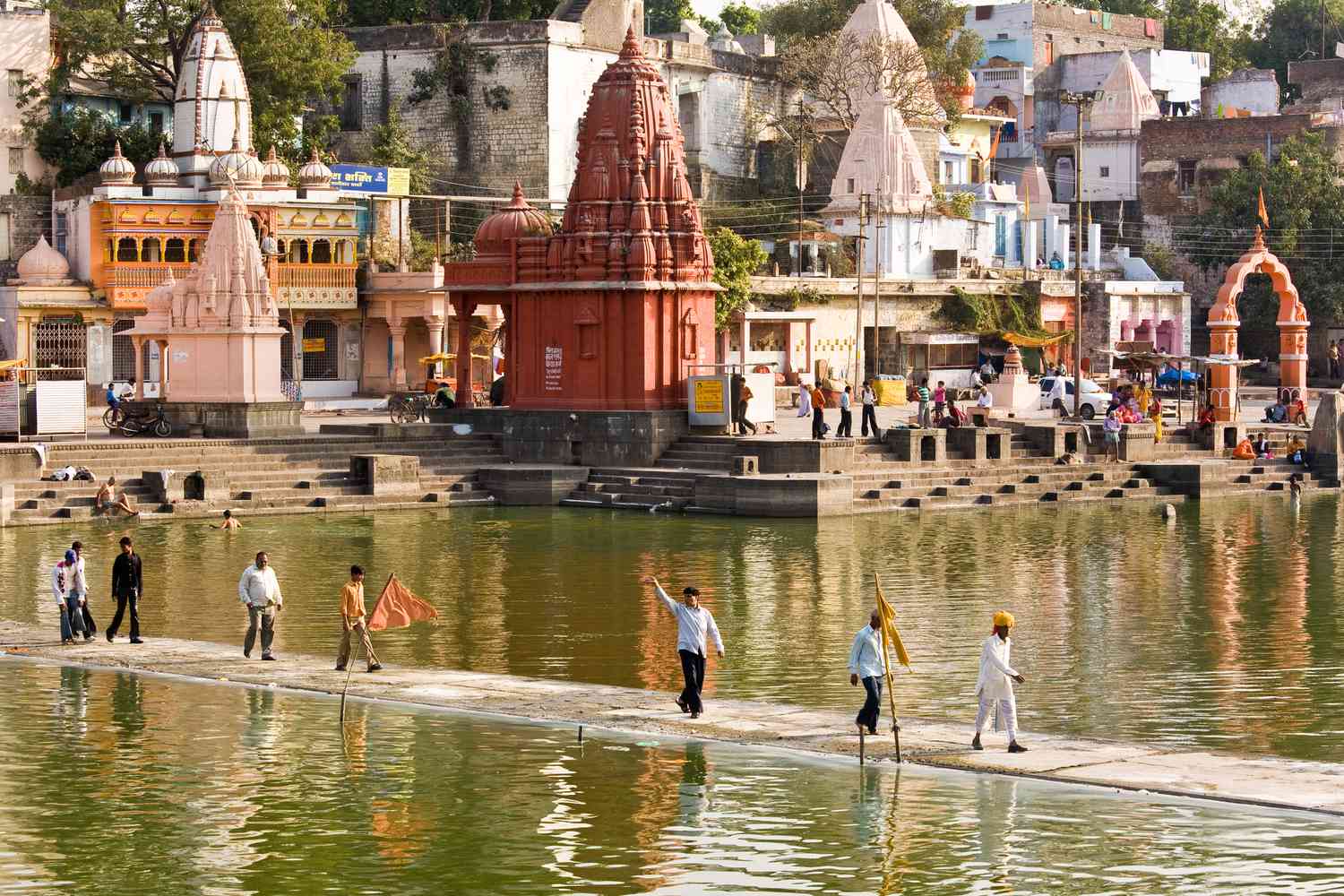
How to Reach
Madhya Pradesh is well connected world wide and within India. Being one of the largest states, Madhya Pradesh has many airports to connect both international and domestic.
By Air: Madhya Pradesh is very well connected through air both international and domestic. The state has five major airports in which two are international and three are domestic. The state has direct flights from Mumbai, Delhi, Bengaluru and many other cities. Raja Bhoj International Airport in Bhopal and Devi Ahilyabai Holkar International airport in Indore provide both domestic and international flights. Gwalior, Jabalpur and Khajuraho have flight connectivity to all major cities of India.
By Railway: The state has an extensive rail network which connects to major cities across India. There are around 20 major junctions which connect the state with the rest of India.
By road: The state is connected to the neighboring states with good National and State highways namely Gujarat, Rajasthan, Uttar Pradesh, Bihar, Jharkhand, Chhattisgarh and Maharashtra. Interstate bus services are available from several cities and towns.
Culture of Madhya Pradesh
Culture of Madhya Pradesh:
The culture of Madhya Pradesh is a vibrant and diverse mix of different religions, languages, and customs. The state is home for people from all major religions in India, including Hindus, Muslims, Christians, Jains, and Sikhs. There are also a number of tribal communities living in Madhya Pradesh, such as the Bhils, Gonds, and Oraons. The state was initially ruled by the Gonds tribals who were mostly present in the jungles south of Jabalpur. The culture of Madhya Pradesh is reflected in its art, architecture, music, dance, and food.
The state is home to some of the most iconic monuments in India, such as the Khajuraho temples, the Sanchi Stupa, Rock shelters of Bhimbiketa . The state is famous for its intricate handwoven sarees like Chanderi and Maheswari as well as the art forms such as Gond and Bhil painting. Indore is famous for its Cari work and embroidery. Art lovers can explore the Gwalior school of Classical Music, the exquisite bamboo work, the intricate terra cotta work, tribal painting and the unique fabric weaves which offer an insight into the cultural richness of Madhya Pradesh.
Madhya Pradesh is also known for its rich folk art and culture. The state has a number of traditional folk dances, such as the Rai dance, the Bhil dance, and the Gond dance. The Matki, Phulpati, and Grida Dance of the Bhils, the Saila Dance of the Gonds, the Karma Dance of the Baigas offer rich, rhythmic landscapes full of color and vigor, signifying their joy and celebration of life.
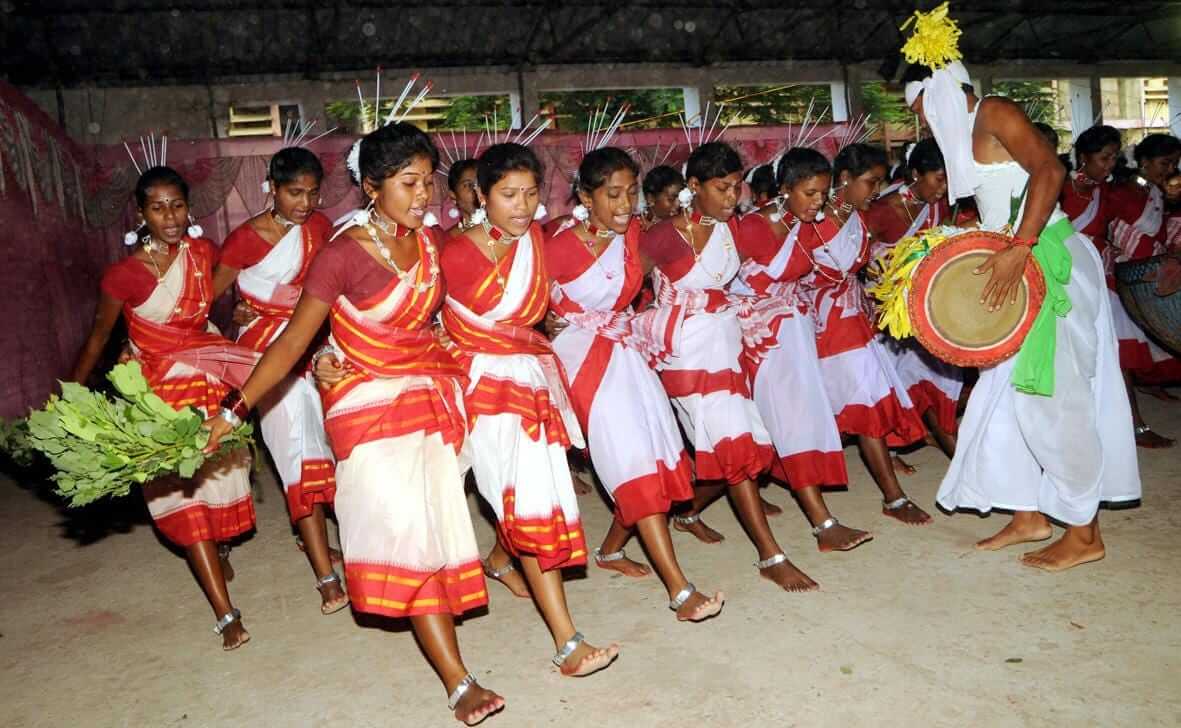
Madhya Pradesh is also home to a number of traditional musical instruments, such as the dholak, the tabla, and the sitar. The state is also known for its rich musical and dance traditions. Some of the most popular folk dances of Madhya Pradesh include the Gaur dance, the Muria dance, and the Sugga dance. The Gaur dance is a martial dance that is performed by the Gonds tribe. The Muria dance is a fertility dance that is performed by the Murias tribe. The Sugga dance is a courtship dance that is performed by the Bhils tribe.
The state is famous for Hindustani Classical music gharanas which include Maihar gharana, the Gwalior gharana and Senia gharana. The food of Madhya Pradesh is also a reflection of its diverse culture. The state is known for its spicy and flavorful dishes, such as poha jalebi, malpua, and dal bati churma. Madhya Pradesh celebrates a number of festivals throughout the year. Some of the most popular festivals include Diwali, Holi, and Navratri. The state also holds Khajuraho Dance Festival, Tansen Music Festival and Mandu Festival every year.
History of Madhya Pradesh
The history of Madhya Pradesh is rich and diverse, with a legacy that spans thousands of years. It can be divided into three different stages as ancient, medieval and modern periods. Madhya Pradesh has a rich and ancient history that dates back to the prehistoric era. The region was inhabited by early humans as early as 300,000 years ago. Evidence of this early habitation can be found in the form of rock paintings, stone tools, and other artifacts. Some of the rock paintings, stone and metal shows around the rivers, valleys, and other areas of Madhya Pradesh indicate that the area has been inhabited since prehistoric times.
The region was once home to extensive empires of the Maurya's, Guptas, and Harsha. The medieval period saw the dominance of Rajput's, Mughals, Marathas, and later the British. The Mughals established their firm control over this vast region. Following which Marathas were able to push back the Muslim invaders to extend their supremacy to areas in and around Avanti mahajanapada. Here's a brief overview of the historical events and developments in Madhya Pradesh.
- Ancient Period:
- The region of Madhya Pradesh has a deep historical connection dating back to ancient times. It was part of various ancient empires and kingdoms, including the Mauryan and Gupta empires.
- Ashoka, the famous Mauryan emperor, is believed to have ruled over parts of present-day Madhya Pradesh, and his inscriptions can still be found in the region.
- The UNESCO-listed Sanchi Stupa, built during the reign of Emperor Ashoka in the 3rd century BCE, is one of the most significant Buddhist monuments in India.
- Medieval Period:
- Madhya Pradesh witnessed the rise and fall of several dynasties during the medieval period. The Parmara dynasty, which ruled from its capital at Ujjain, was one of the prominent ruling families in the region.
- The 10th-century Gwalior Fort, constructed by the Tomara dynasty, remains an architectural marvel from this era.
- Mughal Rule:
- The Mughal Empire expanded its influence into the region in the 16th century. Cities like Bhopal and Gwalior became centers of Mughal administration.
- The 17th-century Taj-ul-Masajid in Bhopal is one of the largest mosques in India and a significant architectural relic from the Mughal era.
- Maratha Rule:
- The Marathas established control over large parts of Madhya Pradesh in the 18th century, with Maheshwar as their capital.
- The Holkar dynasty was one of the prominent Maratha ruling families in the region. Indore served as their capital.
- British Colonial Period:
- During the British colonial period, Madhya Pradesh was part of the Central Provinces and Berar, a British-administered region.
- The state played a significant role in the Indian independence movement, with leaders like Rani Durgavati and Tatya Tope hailing from this region.
- Post-Independence:
- After India gained independence in 1947, the region underwent administrative changes, and Madhya Pradesh was formed as a separate state in 1950.
- Bhopal became the capital of the newly created state, and the state continued to grow and develop in various sectors, including agriculture, industry, and education.
- Modern Period:
- Madhya Pradesh has experienced significant development in various fields since independence. It is known for its agricultural output, mineral resources, and industrial growth.
Tourism in Madhya Pradesh
Madhya Pradesh tourism, with its vast array of historical landmarks, cultural traditions, majestic architecture, vibrant festivals, beautiful landscapes, and diverse wildlife, offers a fascinating exploration of the 'Heart of Incredible India'. One cannot help but be impressed by the sheer diversity and richness of Madhya Pradesh tourism. From heritage monuments and ancient temples to wildlife reserves, from mountainous terrains to serene rivers, from bustling cities to quiet tribal regions, the state’s stark contrasts and striking beauty leave one in awe.
Each city sheds light on a different aspect of the history and culture of this fascinating state. Let's not forget Others like Dhar, Vidisha, Barwani, Hoshangabad, and more which too have a distinctive narrative and charm that deserves recognition and exploration.
National Parks
The state is known as the tiger state with many National Parks. Some of the important National parks in Madhya Pradesh include Kanha, Bandhavgarh National Park and Pench National Park. Satpura National Park, Panna, Kuno National Park. There are around 11 National Parks and 25 wildlife sanctuaries in Madhya Pradesh. Some of the wildlife sanctuaries in Madhya Pradesh are Bori, Bagdara, Phen, Ghatigaon, Ken Gharial and Pachmarhi.
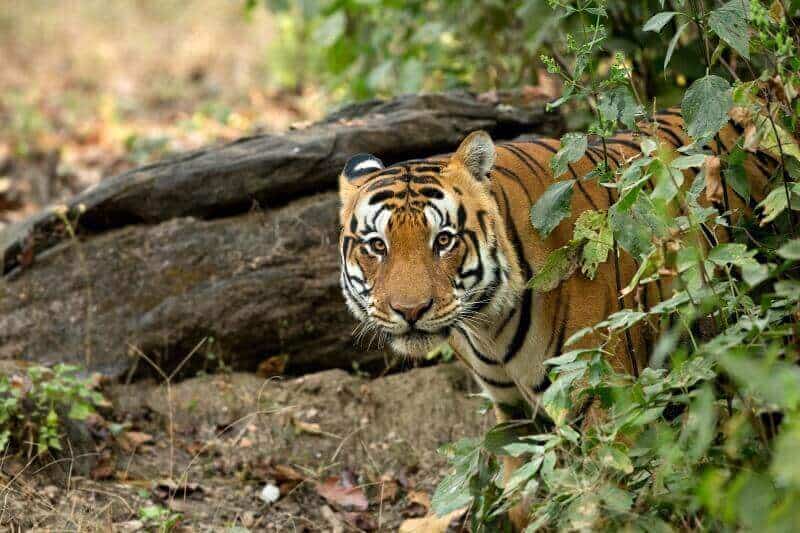
Heritage places in Madhya Pradesh:
One can't overlook the significance of the Khajuraho temples. Designated as UNESCO World Heritage sites, these temples display some magnificent artworks and architectural brilliance portraying the reign of the Chandela dynasty.
Further delving into the historical aspects, we move to the Sanchi Stupa, another UNESCO world heritage site, boasting the rich legacy of the Buddhist era. Initially commissioned by Emperor Ashoka, the Stupas magnificently depict Buddha's life and teaching through carvings and inscriptions.
The historical city of Mandu paints a picture of the bygone era with its spectacular ruins of palaces, mosques, and tombs. Jahaz Mahal, Hindola Mahal, Rupmati’s Pavilion, and Baz Bahadur's Palace reverberate the tales of love, valor, and sacrifice of its glorious past.
The Bhimbetka Rock Shelters are another must-visit historical site. Recognized by UNESCO, these ancient rock shelters display the early traces of human life on the Indian Subcontinent, taking you back to the Prehistoric times.
The serenity and charm of Pachmarhi, an exquisite hill station, also referred to as the 'Queen of Satpura,' serve as a perfect getaway for nature lovers. The breathtaking waterfalls, ancient caves, and panoramic sunset points make this a popular destination among tourists.
Ujjain, a city of temples, draws pilgrims from across the globe. One of the seven sacred cities of the Hindus, Ujjain’s Mahakaleshwar Jyotirlinga is a prominent pilgrimage spot.
One of the 12 Jyotirlingas is located here. This makes it a major pilgrimage site for Hindus. Ujjain is also one of the seven sacred sites which host the Kumbh Mela. The city of Maheswar, situated on the banks of the holy River Narmada, is called the “Varanasi of Central India.”
Orchha, on the banks of Betwa river, is predominantly known for its grand palaces, temples and forts. The spectacular views of sunset at the cenotaphs, river rafting, and the stunning light and sound show at the Orchha Fort Complex add to your enriching tourism experience.
A trip to Madhya Pradesh would be incomplete without a visit to Maheshwar, known for its quiet ghats, ornate temples, and the eminent Maheshwari sarees. The massive fort complex and the heartwarming simplicity of the town create a celebration of elegance and antiquity.
The Chanderi town, world-famous for its Chanderi sarees, is another eye-catching site. With more than 1200 Bauddhi and Jain temples and several magnificent monuments dating back to the medieval era, Chanderi rightly represents the beautiful blend of culture, history, and heritage of Madhya Pradesh.
The Bagh Caves, famous for their mural paintings from the Gupta period, gives another glimpse into the artistic excellence of the ancient periods.
The city of Jabalpur is another gem of Madhya Pradesh, especially popular for Bhedaghat falls and Marble Rocks. The river Narmada winding through the marble rocks and plunging into the waterfall is an enchanting sight to behold.
Also, for those seeking serene spiritual environments, Jain temples at Sonagiri near Datia, Saas-Bahu temples at Gwalior and Bhojeshwar temple at Bhojpur have a lot to offer. The architectural mastery and spiritual essence in these temples are a testament to Madhya Pradesh’s religious diversity.
Here are some tips for planning your trip to Madhya Pradesh:
- The best time to visit Madhya Pradesh is during the winter months (October to March), when the weather is pleasant.
- The state has a well-developed transportation network, so one can easily travel to different tourist destinations by train, bus, or car.
- There are a variety of accommodation options available in Madhya Pradesh, from budget hotels to luxury resorts.
- Try some of the local delicacies, such as poha jalebi, malpua, and dal bafla.
- Madhya Pradesh is a large state, so it is important to plan your trip carefully and decide which tourist destinations you want to visit.
Affiliate Disclosure:
If you make any purchase via a link on this site, I may receive a small commission with no added cost to you.
